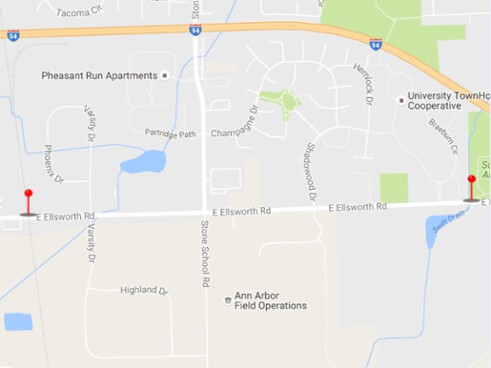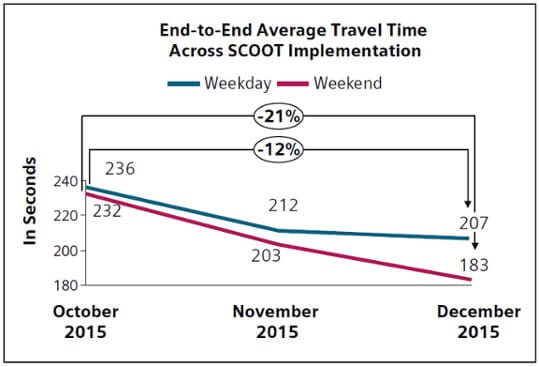
Measuring Big Data’s Impact: Siemens SCOOT Adaptive Traffic Signal Control Technology

Note: This is a guest blog post from Wendy Tao, the Head of Business Development and Strategy of the Intelligent Transportation Systems Group at Siemens Mobility. Wendy helps communities develop Smart Cities solutions related to advanced traffic management systems, adaptive signal control, connected vehicles and multi-modal applications.
From Intelligent Transportation Systems (ITS) to Massive Mobile Data, innovative technologies are tackling decades old challenges and creating new opportunities in the transportation industry. And it’s not just an idea. We’re seeing significant impacts derived from in-depth evaluations on project performance and cost-effectiveness. Siemens recently partnered with StreetLight Data to measure the impact of a Siemens’ SCOOT adaptive signal control implementation in Ann Arbor, MI. Our empirical before-and-after study showed that SCOOT can reduce travel times by 10 to 20 percent. The study used archival navigation-GPS data from connected cars.
Historically, measuring the impact of transportation infrastructure projects and policies has been difficult for public agencies and private companies alike. The high costs and complex statistical challenges associated with conventional travel data collection were the chief obstacles. Our Ann Arbor case study proves the value of ITS technology for reducing congestion, and it also demonstrates why performance evaluations are useful for a broad range of stakeholders. Companies like Siemens can benefit from knowing how well (or not) a project performs.
Why We Partnered with StreetLight Data
We decided to team up with StreetLight Data because very few before-and-after studies of adaptive traffic signal controls such as SCOOT have been conducted, even though the technology has been in use the 1980s. Unlike traditional signals, SCOOT responds dynamically to congestion (it stands for Split Cycle Offset Optimization Technique). Thanks to sensors located ahead of intersections and intelligent software at the traffic control center level, SCOOT can automatically adjust timing in response to real-time travel patterns. Although there we had plenty of anecdotal and qualitative evidence that SCOOT is effective, the majority of North American studies were conducted back in the nineties. The technology has matured significantly since then, so we wanted up-to-date, empirical evidence of SCOOT’s effectiveness – not stale data that described a much older product.
It was important for us to work with StreetLight Data for this study because travel behavior data was not collected prior to SCOOT’s implementation in Ann Arbor. Without a record of travel times prior to deployment, it would be impossible to measure the difference SCOOT made. Because StreetLight Data’s analytics are derived from archival data going back to January 2014, we could run analyses retroactively. In effect, we “went back in time” to gather information that we had no other way to obtain.
What We Learned
Using the StreetLight InSight® platform, the StreetLight Data team helped us run a corridor study that measured travel times down an Ann Arbor corridor before and after SCOOT was installed in November 2015. Figure 1 (below) shows how the study was set up.


Figure 1: The above map shows the 2-mile segment of Ellsworth Road that was analyzed in StreetLight InSight. We measured the duration of trips between the two pins. Ellsworth Road has a single lane in each direction, but it has high traffic volumes because drivers who want to avoid congestion on I-94 often use it as a bypass. Because Ellsworth Road is located near University of Michigan, it is particularly congested when special events are held on campus.
More than 11,000 complete trips traveling along the entire length of the 2-mile corridor were measured. An additional 30,000 trips that traveled along a portion of the corridor, but not from end to end, were also studied. As shown in Figure 2 (below), the before-and-after study showed that travel times improved by 10 to 20 percent depending on the type of day (weekends and weekdays were analyzed separately). The biggest difference was observed on weekends.
Figure 2: This chart was created using StreetLight InSight Trip Attributes Metrics, which include trip duration in seconds as well as trip length, trip speed, and circuity. Thanks to SCOOT, weekday trips along the corridor took 12% less time and weekend trips took 21% less time than they did previously.
The Value of Performance Measurement
For Siemens, the value of this project was clear. We now have recent, empirical evidence of SCOOT technology’s positive impact. It clearly demonstrates SCOOT’s advantages using measured, real-world trips. We’re optimistic that the ability to conduct timely and cost-effective studies should make governments more open to adopting these systems, since effectiveness and Return on Investments (ROI) can be more easily demonstrated.
These types of studies could also be useful to anyone implementing transportation policies, technology, and infrastructure who want to evaluate the impact of their work. Consulting firms are one example that comes to mind. These types of evaluations can also help the industry set benchmarks for success.
When we in the transportation industry evaluate project performance empirically, we can more reliably forecast the policies and projects that will make the most positive impact. With easy-to-understand, real-world data in-hand, transportation experts can more effectively build public support for their plans and more effectively lobby public officials for much-needed funding. Furthermore, these evaluations can help us conduct more accurate and complete cost-benefit analyses so cities can confidently allocate their taxpayers’ valuable dollars to the most beneficial projects.
But the ultimate beneficiaries of these types of studies are not companies or government entities – the communities that we serve who stand to gain the most in the long run.

